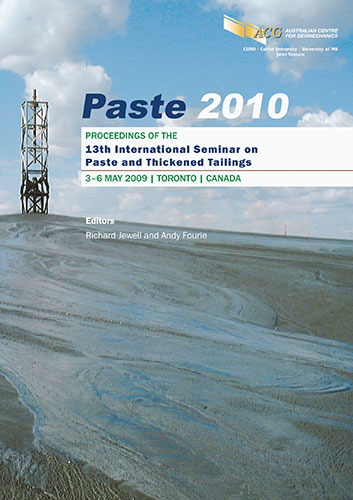Evaluating the benefits of paste fill using advanced schedule optimisation techniques

|
Authors: Maybee, BM; Hall, S; Tousignant, A |
DOI https://doi.org/10.36487/ACG_rep/1063_15_Maybee
Cite As:
Maybee, BM, Hall, S & Tousignant, A 2010, 'Evaluating the benefits of paste fill using advanced schedule optimisation techniques', in R Jewell & AB Fourie (eds), Paste 2010: Proceedings of the Thirteenth International Seminar on Paste and Thickened Tailings, Australian Centre for Geomechanics, Perth, pp. 175-183, https://doi.org/10.36487/ACG_rep/1063_15_Maybee
Abstract:
Operational decisions within the underground mining industry have the ability to offer substantial increases in value if they can be made early in the project planning stage. The choice of fill technology is one of these operational decisions that have the potential to add significant value to the project. However, due to the manually intensive requirements to schedule the operations under multiple designs to allow for the comparison of the different technologies, the benefits are usually undervalued. In many cases, the benefits from a change in fill technology are limited to an evaluation of the sensitivity of the design to changes based on a modification in fill rate and curing times. What is generally not taken into account, due to time constraints, is that a change in fill technology may also allow for introduction of a completely new mining sequence. This might require a different equipment fleet and a completely different schedule, which may dramatically enhance the value of the project. These are not mutually exclusive decisions, and if a proper evaluation of the fill technology is to be undertaken, then all of the potential benefits and pitfalls must be included as the competing scenarios are evaluated for potential implementation. The Schedule optimisation tool (SOT) developed at MIRARCO uses advanced technology and computing power to identify and evaluate thousands of sequences and scheduling alternatives in a relatively short period of time. Through its optimisation process, SOT uses a powerful genetic algorithm to create multiple sequences of increasing value as it completely re-orders the activity set to find better sequences and schedules for the given design. Alternate designs can be considered in the same manner and new research is underway to develop rapid evaluation of multiple design options. As a result, a full scenario evaluation is possible, accounting for the fact that an improved mining sequence and equipment fleet utilisation may exist for a given change in fill technology. This paper describes how SOT can be used to identify the true scheduling benefits (as measured by net present value) that can be realised by a mining project through the use of paste fill. Through the use of case study data, it is demonstrated that the value of the mine can be substantially increased if all of the decision variables, both timing and operational efficiencies, related to that choice are accounted for in the evaluation.
References:
Amaratunga, L. and Yaschyshyn, D. (1997) Development of a high modulus paste fill using fine gold mill tailings,
Geotechnical and Geological Engineering, Vol. 15, pp. 205–219.
Blattman, M. (2003) Creation of an underground mine development sequencing optimizer, In Proceedings 2003 SME
Annual Meeting, Cincinnati, USA, Preprint 03-064, 8 p.
Fava Lindon, L., Goforth, D., van Wageningen, A., Dunn, P., Cameron, C. and Muldowney, D. (2005) A parallel
composite genetic algorithm for mine scheduling, In Proceedings 9th IASTED International Conference on
Artificial Intelligence and Soft Computing, A.P. del Pobil (ed), Anaheim: ACTA Press, pp. 245–250.
Hall, B. (2003) How mining companies improve share price by destroying shareholder value, presented at CIM Mining
Conference and Exhibition, Montreal, www.amcconsultants.com.au, 31 p.
Hall, B. and Stewart, C. (2004) Optimising the Strategic Mine Plan – Methodologies, Findings, Successes and Failures,
Orebody Modelling and Strategic Mine Planning Symposium: Spectrum Series 14, Orebody Modelling and
Strategic Mine Planning: Uncertainty and Risk Management, R. Dimitrakopoulos (ed), Perth: AusIMM,
pp. 281–288.
Underground and backfill applications
Paste 2010, Toronto, Canada 183
Maybee, B., Fava, L., Dunn, P., Wilson, S. and Fitzgerald, J. (2009) Towards optimum value in underground mine
scheduling, presented at CIM AGM, Toronto, USA, 10 p.
Michalewicz, Z. (1992) Artificial Intelligence, Berlin, Germany, Springer-Verlag.
Pegman, M., Forward, N., King, B. and Teal, D. (1996) Mine Planning and Scheduling at RTZ Technical Services,
Customer Technical Papers, www.ilog.com/products/optimization/tech/custpapers.cfm, 10 p.
Evaluating the benefits of paste fill using advanced schedule optimisation techniques B.M. Maybee et al.
184 Paste 2010, Toronto, Canada
© Copyright 2025, Australian Centre for Geomechanics (ACG), The University of Western Australia. All rights reserved.
View copyright/legal information
Please direct any queries or error reports to repository-acg@uwa.edu.au
View copyright/legal information
Please direct any queries or error reports to repository-acg@uwa.edu.au